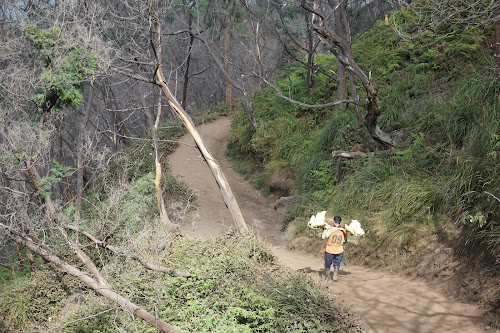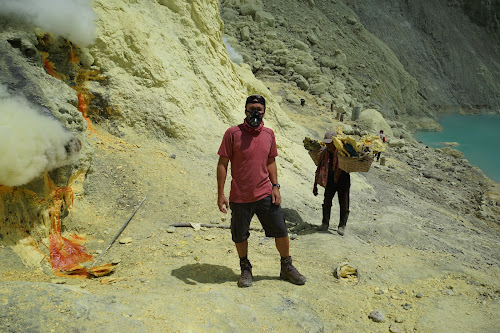One of the reasons we decided to travel across Java was to experience the island's food, culture, people and volcanic landscape. As we rode the train east we watched the landscape change from big city Yogyakarta to villages of rice fields to thick jungle and coffee plantations. We stopped in Malang, in the centre of the eastern volcanoes, and then in Banyuwangi, on to the east coast where we ended up in gas masks...
Our stop in Malang was for a couple of days and was really only because it was on the way to the volcanic mountains. Although it turned out to be one of my favourite cities in Java! Our first night we found some really great restaurants and little Warung's (street food centres). Everyone we met here was genuinely nice and loved to yell out "Hello mister! How are you?" as we walked by (and yes, I'm also a "mister"). This was the first time since arriving in Indonesia that we didn't feel like walking "$". As we wandered around town, we found ourselves in the middle of a huge parade. The soccer team from Probolingo, a big town about two hours away, was playing and everyone was getting pumped up!
We then found ourselves at the Bird Market where we saw thousands of caged birds including live bird feed (insects and worms). We didn't realize though that we would also see caged iguanas, cats, dogs, owls, monkeys and even bats! It was really sad. A German woman we passed said it best " it really makes your animal heart hurt".
After that, I needed some soul cleansing and went to the next street over: the Flower Market
Our last stop was this really weird museum that was badly signed with terrible english translations. Although, the best part was the random man who coached us in how to take "good" photos in the museum:
 |
| Look at the beautiful view from up here! |
 |
| Going in for a swim! |

|
| Part of an archeological dig. |
One of the things we have been regularly doing on this trip is making last minute decisions. So on our last night in Malang, we had to decide which volcano did we want to visit: Mt. Bromo for a beautiful sunrise hike and walk across the ultra popular crater plateau, along with a million other tourists, or Mt Ijen crater where there's a sulphur mine and a blue acidic lake with a ph level of 0.5, located on the east coast and typically not on the tourist track? After seeing some spectacular volcanic landscapes in New Zealand, we decided on Mt. Ijen as something different.
To get to this crater it is an hour drive from the town of Bayuwangi and then a one hour hike uphill on a 3km steep dusty (i.e. slippery when going downhill) path. Within minutes of starting our hike, we came face to face with our first miner: A fit Indonesian man carrying his load of sulphur down from the crater.
After about another few minutes we encountered another miner, then another, then another. We regularly saw miners going downhill with full loads as we hiked up. Finally, just as we rounded the last bend in the path and just below the crater edge, we came upon a dozen miners packing up their loads in their bamboo baskets or fancy carts.
One of the things that came to mind as we arrived at the crater was "too bad it's so cloudy" but it turned out that the huge "cloud" was actually gas billowing up from the sulphur vents! We hiked around the lip of the crater for better views.
The intensity of the sulphur smell was overwhelming and I was so glad we had rented these masks because without them I would have been sick. Even just as we first started our hike around the crater I had thought that I could handle the smell, even Tom mentioned it reminded him of Rotorua in New Zealand! But after a few minutes I was coughing and my throat was starting to burn; masks on.
The views were spectacular and lake Ijen is incredibly blue. You could even see a bit of a mist coming off the lake, which I assume is more sulphur gas. I read somewhere that the acidity of the lake is equal to a car battery!
Because Tom was able to deal with the sulphur gas much better than I could, along with a local guide, he hiked down into the crater to see the actual vents and the mining spot. At the bottom, it looked like they installed a pipe at the vents so that the sulphur gas would cool around the pipe opening which would then result in solidified sulphur.
Tom had to wear his masks for this trip down because the odours were way too strong; it was even making his eyes water. What is absolutely crazy though is that these miners go up and down into the crater every day, twice a day, hauling out anywhere from 60 to 90kg a trip, without any breathing apparatus or eye protection. They are completely exposed to the elements. One of the miners taking a break that Tom passed on his way back up, looked so tired and exhausted that Tom offered him his water. He took it eagerly and chugged. After that we noticed that most miners only carried small 250ml water bottles and they all looked emply. The other thing I noticed was a huge hump on a miner walking in front of me located on his upper back just below his neck. The sad part was that this miner was pretty young, probably in his early 20's. I have no idea what kind of physiological effect this work has on these men but I can only imagine that their bodies break down way too soon in their lives. We learned that these men get about $0.10/kg of sulphur, so about $12-18CDN per day, which is a pretty decent income here.
The natural beauty of the rocky crater and the blue-green lake with this sulphury smoke billowing up to the atmosphere was incredible and the experience of seeing these sulphur miners working in it will be something that will stay with me forever.




































No comments:
Post a Comment